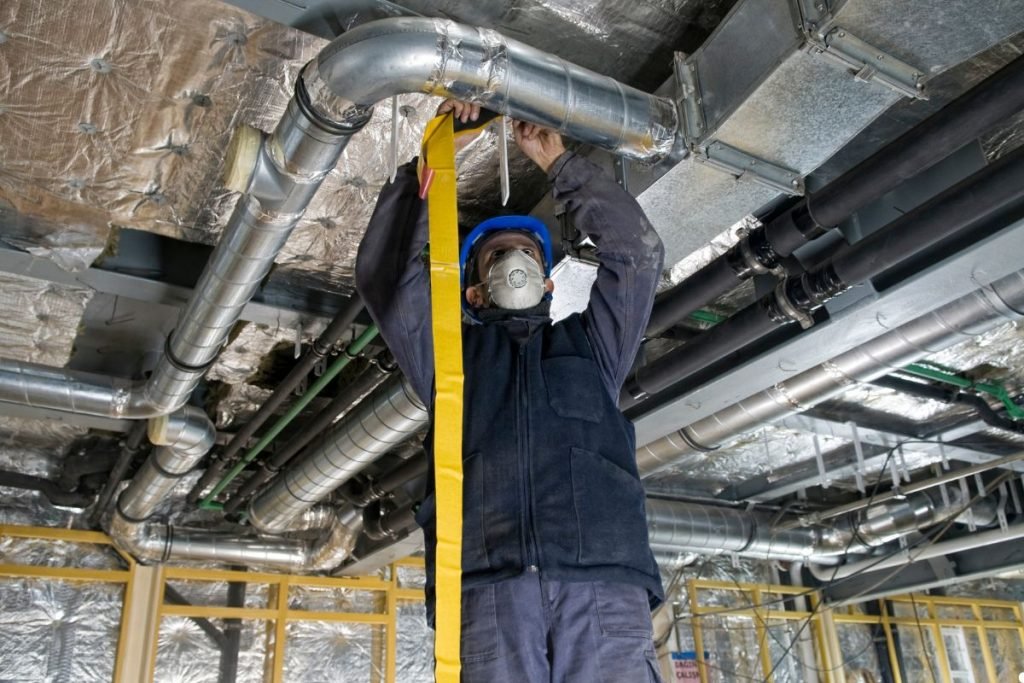
Are you hearing strange noises from your vents, noticing uneven temperatures throughout your home, or seeing a sudden spike in your energy bills? These could be tell-tale signs that your air ducts need attention. Knowing when your ductwork requires repair is crucial for maintaining home comfort, ensuring good indoor air quality, and keeping your HVAC system running efficiently. Ignoring potential problems can lead to wasted energy, higher costs, and unnecessary strain on your heating and cooling equipment. This guide will walk you through the common indicators that signal it’s time to consider duct repair. If you’re experiencing any of these issues, don’t wait—call us today to schedule a professional duct inspection and repair!
What Are Air Ducts and Why Do They Matter?
Think of your air ducts as the circulatory system for your home’s heating, ventilation, and air conditioning (HVAC) system. This network of pathways, often hidden behind walls, ceilings, and floors, is responsible for distributing the conditioned air (heated or cooled) from your furnace or air conditioner to every room in your house. They also return air back to the HVAC unit to be reconditioned.
Properly functioning ductwork is essential for both home comfort and energy efficiency. When ducts are well-sealed and insulated, they deliver air effectively, maintaining consistent temperatures and preventing your HVAC system from working harder than necessary. Damaged or leaky ducts, however, can undermine the entire system’s performance. If your ducts run through uninsulated areas, adding crawl space insulation can significantly improve overall home comfort.

Clear Signs Your Ductwork Needs Attention
Sometimes, your ducts send out obvious distress signals. If you notice any of the following, it’s a strong indication that repairs might be needed:
- Strange Noises: Are you hearing rattling, whistling, popping, or booming sounds when your HVAC system runs? Loose connections, debris, holes, or even improperly sized ducts can cause these noises. Rattling often points to loose sections, while whistling can indicate leaks or blockages.
- Visible Damage: Take a look at any exposed ductwork in your attic, crawl space, or basement. Do you see obvious tears, holes, kinks, or crushed sections? Physical damage significantly compromises airflow and leads to major leaks.
- Poor Airflow from Vents: Do some rooms feel stuffy while others are comfortable? Is the air coming out of certain vents much weaker than others? Blockages, leaks, or disconnected ducts can restrict airflow, leading to uneven heating and cooling.
- Excessive Dust Around Vents: While some dust is normal, finding excessive amounts accumulating around your supply vents shortly after cleaning can indicate leaks in the return ducts pulling dusty air from attics or crawl spaces, or leaks in the supply ducts blowing dust out.
Subtle Clues Pointing to Duct Issues
Not all duct problems are loud or obvious. Sometimes, the signs are more subtle but equally important:
- Unusually High Energy Bills: If your heating and cooling costs have crept up without a corresponding change in weather or usage habits, leaky ducts could be the culprit. Leaks can force your HVAC system to run longer and harder to compensate for lost conditioned air – sometimes losing 20-30% of the air moving through them, Energy Star estimates.
- Uneven Heating or Cooling: Are there distinct hot or cold spots in your home? While insulation or window issues can play a role, leaky or poorly designed ductwork is a common cause of inconsistent temperatures between rooms.
- Musty Odors or Poor Indoor Air Quality: Do you notice musty or moldy smells when the HVAC system kicks on? Leaks can draw in contaminants like dust, mold spores, insulation fibers, and pollutants from unconditioned spaces (attics, crawl spaces), circulating them throughout your home and worsening allergies or respiratory issues.
- Signs of Pest Infestations: Droppings, nests, or chewed materials near ductwork can indicate that rodents or insects have found their way in. Pests can damage ducts and introduce unpleasant odors and contaminants into your airflow.
Why You Shouldn’t Ignore Duct Problems
Ignoring signs of duct damage might seem harmless initially, but it can lead to significant problems down the line:
- Wasted Energy & Money: Leaky ducts mean conditioned air escapes into unoccupied spaces like attics or crawl spaces instead of reaching your living areas. This energy waste translates directly into higher utility bills.
- Reduced Comfort: Uneven temperatures, poor airflow, and stuffy rooms are direct results of malfunctioning ductwork, making your home less comfortable.
- Strain on HVAC Equipment: When ducts leak, your furnace and air conditioner have to work much harder and run longer to reach and maintain the desired temperature. This extra wear and tear can lead to premature breakdowns and costly repairs.
- Compromised Indoor Air Quality: Leaks pull in dust, allergens, mold spores, insulation particles, and other pollutants from outside the living space, circulating them throughout your home and potentially impacting your family’s health.
DIY Checks vs. Calling a Professional HVAC Technician
While some basic checks can be done yourself, duct repair often requires professional expertise:
- Simple Visual Inspections: You can visually inspect accessible ductwork in basements, attics, or crawl spaces for obvious tears, disconnected joints, or crushed sections. You can also check airflow at vents and listen for unusual noises. Sealing minor, easily reachable leaks with mastic sealant or specialized foil tape not standard duct tape might be a temporary DIY fix.
- When Professional Help is Necessary: Diagnosing hidden leaks, assessing the overall condition of the system, properly sealing complex joints, repairing damaged sections within walls, or addressing insulation issues requires specialized tools and knowledge. Professionals use tools like duct leakage testers (blower doors) and cameras to accurately pinpoint problems and ensure repairs are done correctly and meet local building codes. They can determine if sealing, repair, or even replacement is the best course of action. Our services are performed by experienced professionals who ensure all repairs comply with local building codes and industry standards.

Maintaining Healthy Ducts for a Healthy Home
Your air ducts play a vital role in your home’s comfort, efficiency, and air quality. Paying attention to the signs – whether loud noises and visible damage or subtle clues like high bills and uneven temperatures – is key.
Ignoring potential duct issues leads to wasted energy, reduced comfort, strained equipment, and poor indoor air quality. While simple visual checks can be helpful, accurate diagnosis and effective repair often require professional intervention. If you suspect your ductwork needs attention, don’t hesitate. Don’t let faulty ducts compromise your comfort and efficiency—contact us for a thorough inspection. Our experts are ready to restore your system’s performance.
Frequently Asked Questions About Duct Repair
Here are answers to some common questions homeowners have about ductwork:
How often should ducts be inspected?
While there’s no strict rule, having your ducts professionally inspected every 3-5 years, or sooner if you notice any warning signs, is a good practice. Inspections are also wise during routine HVAC maintenance visits.
Can I repair my own ducts?
Minor, easily accessible leaks might be sealed by a handy homeowner using appropriate materials like mastic sealant or foil tape (not cloth-backed duct tape). However, significant damage, hidden leaks, or complex repairs should always be handled by a qualified HVAC professional to ensure safety and effectiveness.
What is the cost of duct repair?
The cost varies widely depending on the extent of the damage, accessibility of the ducts, size of your home, and local labor rates. Minor sealing might cost a few hundred dollars, while extensive repairs or replacements can cost significantly more. A professional inspection will provide an accurate estimate.
How long does duct repair take?
Simple sealing jobs might take a few hours. More complex repairs involving accessing hidden ductwork or replacing sections could take a full day or longer. Your technician can give you a time estimate after assessing the situation.
Is duct cleaning the same as duct repair?
No, they are different services. Duct cleaning removes dust, debris, and contaminants from within the duct system. Duct repair involves fixing physical damage like leaks, holes, disconnected sections, or insulation problems. While sometimes done together, cleaning doesn’t fix leaks, and repair doesn’t necessarily clean the entire system. Call us today to schedule a professional inspection or service and keep your HVAC system running efficiently!
